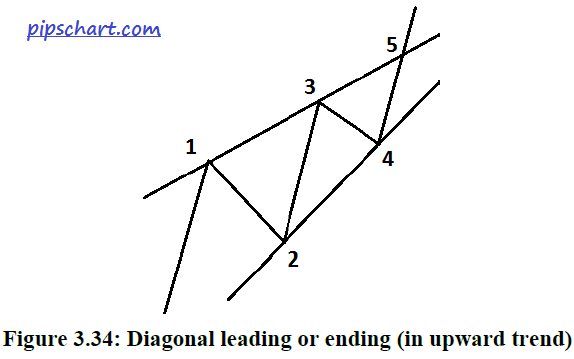Diagonal and Truncation part of wedge pattern
Diagonal and Truncation part of wedge pattern
A diagonal (see Figure 3.34) is the same as the classic wedge pattern seen in classic technical patterns. It is simply a triangle formation with both bounds headed in the same direction but at different angles so that they will meet at some point in the future.
Diagonal patterns can appear in wave 1 or wave 5. If a diagonal appears in wave 1, it is called a “leading diagonal.” A diagonal appearing in wave 5 is called an “ending diagonal.” A diagonal never occurs in wave 3. The direction of the diagonal bounds is the same direction as the trend of the higher degree impulse wave.
A leading diagonal usually consists of five sub waves of three wavelets, each a 3-3-3-3-3 configuration converging toward an apex. Occasionally, however, the configuration is 5-3-5- 3-5, just as in an impulse but with the overlapping of waves 2 and 4 (Frost and Prechter, 2000).
An ending diagonal also includes five sub waves, each of which is in turn subdivided into three smaller waves. Often, the fifth sub wave will break out of the diagonal’s bounds for a short period before reversing. This is called a “throw-over” (Frost and Prechter, 2000).
A throw-over is an “elongated impulse with exaggerated subdivisions.” Usually an extension will occur in only one of the sub waves in an impulse pattern. Thus, if waves 1 and 5 are approximately the same length, wave 3 likely will be extended.
In fact, the third wave extension is the most common extended wave pattern in the stock market. In commodities, however, the extended wave is usually the fifth wave. When extended, a wave often appears to have nine sub waves rather than the usual five. This is because the extended wavelets are large enough to appear the same size as the sub waves themselves.
Truncation
Occasionally, the fifth wave fails to exceed the end of the third wave. This phenomenon is shown in Figure 3.35. Elliott referred to this as a “failure.” Nevertheless, a truncated fifth wave will still have five sub waves.



0 thoughts on “Diagonal and Truncation part of wedge pattern”